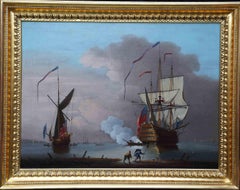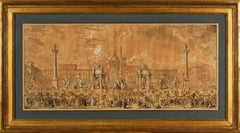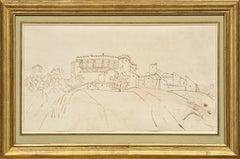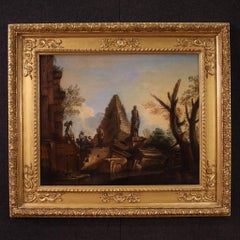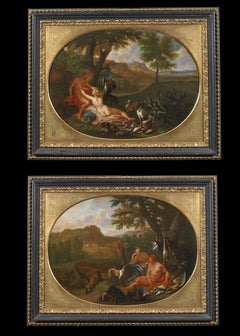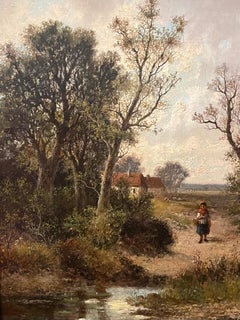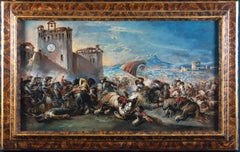1730s Landscape Paintings
to
2
1
2
2
Overall Width
to
Overall Height
to
579
3,061
17,044
27,536
348
331
544
629
699
911
1,000
1,003
1,019
856
306
3
5
3
1
1
1
1
3
3
2
2
2
1
5
5
Period: 1730s
Morning Gun - British Old Master naval marine seascape ships art oil painting
By Peter Monamy
Located in London, GB
This superb British Old Master marine oil painting is attributed to Peter Monamy. Painted circa 1730 it depicts Morning Gun - A morning gun is a gun fired at the first note of revei...
Category
Old Masters 1730s Landscape Paintings
Materials
Oil
$23,803 Sale Price
20% Off
Preparations for the fireworks display held in Piazza Navona in 1729
Located in Paris, Île-de-France
VERY IMPORTANT DRAWING BY
JACQUES DUMONT called « LE ROMAIN"
(Paris 1701-1781)
Preparations for the fireworks display held in Piazza Navona in Rome on November 30,
1729, for the bi...
Category
French School 1730s Landscape Paintings
Materials
Ink, Pen, Chalk
View of a Mansion in the South of France, a drawing by Claude-Joseph Vernet
By Claude-Joseph Vernet
Located in PARIS, FR
We would like to thank Madame Beck-Saiello for confirming the autograph nature of this drawing after an in-person examination.
It was probably during an excursion in the countryside near Avignon that Claude-Joseph Vernet executed this drawing, enhanced with pen and brown ink, depicting a mansion on a hilltop overlooking a small village with geometric shapes.
1. Joseph Vernet, a painter influenced by Italy
Claude-Joseph Vernet was born in Avignon in 1714, the son of Antoine Vernet (1689-1753), an artisan painter of architectural decorations, coach panels, and the like. He moved to the studio of Philippe Sauvan (1697-1792), a leading history painter in Avignon, and then worked with Jacques Viali (active 1681-1745), a decorative, landscape, and marine painter in Aix-en-Provence. Vernet's first recorded paintings were decorative overdoors executed in 1731 in the Aix townhouse of the marquise de Simiane. In 1734, Joseph de Seytres, marquis de Caumont, a leading amateur in Avignon, sponsored Vernet to make a study trip to Italy to complete his artistic education and to draw antiquities for his patron.
As Avignon was a papal territory in Vernet's day, he also had a number of useful introductions among influential churchmen when he arrived in Rome. Vernet was soon at home in the French community there, and he was encouraged by Nicolas Vleughels (1668-1737), director of the Académie de France in Rome, even though the young painter had no official affiliation with the royal institution. He likely entered the studio of the French marine painter Adrien Manglard...
Category
Old Masters 1730s Landscape Paintings
Materials
Ink, Laid Paper, Pen, Carbon Pencil
18th Century Oil on Canvas Italian Capriccio Painting Ruins with Figures, 1730s
Located in Vicoforte, IT
Refined Italian painting from the first half of the 18th century. Oil on canvas artwork depicting a splendid landscape with a capriccio of classical ruins and figures. Painting of re...
Category
1730s Landscape Paintings
Materials
Canvas, Oil
18th Century Galanti Scenes Van Limborch Rest Hunting Oil on Canvas Green Red
Located in Sanremo, IT
Pair of oval paintings measuring 66 x 89 cm without frame and 90 x 115 cm with coeval frame depicting two gallant moments during a rest from hunting by painter Hendrik Van Limborch (...
Category
Old Masters 1730s Landscape Paintings
Materials
Canvas, Oil
Related Items
19th century oil, view London, the Thames, houses parliament, Francis Maltino
Located in York, GB
A fine pair of oil paintings, oil on board depicting views of the Thames one showing houses of parliament the other barges in busy shipping lane.
Framed and Glazed the size being 26 ...
Category
Old Masters 1730s Landscape Paintings
Materials
Oil
$4,868 Sale Price
20% Off
H 16.15 in W 18.51 in D 1.97 in
Landscape Near Felday, Surrey
Located in Hillsborough, NC
Dutch/English artist Abraham Hulk the Younger (1851-1922) is most known for landscapes of the British countryside. This work is one of a pair (the second work is also available by s...
Category
Old Masters 1730s Landscape Paintings
Materials
Canvas, Oil
$2,240 Sale Price
20% Off
H 27 in W 22.75 in D 2.13 in
French Watercolor of Vibrant Square with Painter, Palm Trees, and Architecture
Located in Cirencester, Gloucestershire
Title: French Watercolor of Vibrant Square with Painter, Palm Trees, and Architecture
by Robert Lepine (French, 1929 - 2017)
Signed: Yes
Medium: Watercolor painting on artists paper
...
Category
French School 1730s Landscape Paintings
Materials
Pen, Watercolor
$703
H 14.25 in W 10.25 in D 1 in
After Hendrick MOMMERS (1623-1693) Haarlem Vegetable Market c1750
Located in Holywell, GB
After Hendrick MOMMERS (1623-1693) Haarlem Vegetable Market c1750
An early copy c1750, of an entertaining Dutch vegetable market scene in an Italianate landscape. The original was p...
Category
Old Masters 1730s Landscape Paintings
Materials
Oil
Shepherd with Sheep, Cows and a Goat in a Landscape by Jan Frans Soolmaker
Located in Stockholm, SE
Jan Frans Soolmaker (Flanders 1635‑1685)
Shepherd with Sheep, Cows and a Goat in a Landscape
oil on relined canvas
canvas size 56 x 53 cm
frame i...
Category
Old Masters 1730s Landscape Paintings
Materials
Canvas, Oil
$5,680 Sale Price
25% Off
H 22.05 in W 20.87 in
Christ Samaritan Woman Pozzoserrato Paint Oil on table 17th Century Old master
Located in Riva del Garda, IT
Christ and the Samaritan woman at the well
Attributable to Ludovico Pozzoserrato (Antwerp circa 1550 - Treviso 1605)
Oil on the table
37 x 27 cm., In ...
Category
Old Masters 1730s Landscape Paintings
Materials
Oil
$5,396 Sale Price
20% Off
H 20.48 in W 16.54 in
The Knight - painting - XVII century
Located in Roma, IT
The Knight is an original oil painting on canvas realized during the XVII century by an anonymous artist.
Provenance: Pecci-Blunt collection. Good condition...
Category
Old Masters 1730s Landscape Paintings
Materials
Canvas, Oil
Shipping in Stormy Waters, Attributed to Italian Artist Francesco Guardi
By Francesco Guardi
Located in Stockholm, SE
The splendour of the tragic sea
Francesco Guardi and maritime painting in Venetian art
No Venetian painter was a stranger to the sea. After all, Venice was not only one of the most prominent ports of the Mediterranean, but indeed a city literally submerged in the ocean from time to time. Curiously however, the famous Venetian school of painting showed little interest in maritime motifs, favouring scenes from the iconic architecture of the city rather than seascapes. That is why this painting is a particularly interesting window into not only the painter Francesco Guardi himself – but to the significance of the element of water in art history, in absence as well as in the centre of attention.
Whether it be calm, sunny days with stunning views of the palaces alongside the canals of Venice or – more rarely – stormy shipwrecking tragedies at sea, water as a unifying element is integral to the works of painter Francesco Guardi (1712–1793). During his lifetime, Venetian art saw many of its greatest triumphs with names like Tiepolo or Canaletto gaining international recognition and firmly establishing Venice as one of the most vibrant artistic communities of Europe. While the city itself already in the 18th century was something of an early tourist spot where aristocrats and high society visited on their grand tour or travels, the artists too contributed to the fame and their work spread the image of Venice as the city of romance and leisure to an international audience, many of whom could never visit in person.
Still today, the iconic image of Venice with its whimsical array of palaces, churches and other historic buildings is much influenced by these artists, many of whom have stood the test of time like very well and remain some of the most beloved in all of art history. It was not primarily subtility, intellectual meanings or moral ideals that the Venetian art tried to capture; instead it was the sheer vibrancy of life and the fast-paced city with crumbling palaces and festive people that made this atmosphere so special. Of course, Venice could count painters in most genres among its residents, from portraiture to religious motifs, history painting and much else. Still, it is the Vedutas and views of the city that seems to have etched itself into our memory more than anything else, not least in the tradition of Canaletto who was perhaps the undisputed master of all Venetian painters.
Born into his profession, Francesco lived and breathed painting all his life. His father, the painter Domenico Guardi (1678–1716) died when Francesco was just a small child, yet both he and his brothers Niccolò and Gian Antonio continued in their fathers’ footsteps. The Guardi family belonged to the nobility and originated from the mountainous area of Trentino, not far from the Alps. The brothers worked together on more challenging commissions and supported each other in the manner typical of family workshops or networks of artists. Their sister Maria Cecilia married no other than the artist Giovanni Battista Tiepolo himself, linking the family to the most renowned Venetian name of the time. During almost a decade, Guardi worked in the studio of Michele Giovanni Marieschi, sometimes simply known as Michiel, a painted similar in both style and motif. Canaletto is, however, the artist Guardi is most often compared to since they shared a mutual fascination for depicting the architecture and cityscape of Venice.
During the course of his career, Guardi tried his hand in many different genres. He was as swift in painting landscapes, Vedutas of Venice, sacred motifs, interiors and architectural compositions as he was in a number of other motifs. His style is typical of the Venetian school but also distinct and personal once we look a little closer. There is an absolute certainty in the composition, the choice of which sometimes feels like that of a carefully calculated photograph – yet it is also very painterly, in the best sense of the word: fluid, bold, sensitive and full of character. The brushwork is rapid, intense, seemingly careless and extraordinarily minute at the same time; fresh and planned in a very enjoyable mixture. His interiors often capture the breath-taking spacious glamour of the palaces and all their exquisite decor. He usually constructed the motif through remarkably simple, almost spontaneous yet intuitively precise strokes and shapes. The result was a festive, high-spirited atmospheric quality, far away from the sterile and exact likeness that other painters fell victim to when trying to copy Canaletto.
The painting here has nothing of the city of Venice in it. On the contrary, we seem to be transported far away into the solitary ocean, with no architecture, nothing to hold on to – only the roaring sea and the dangerous cliffs upon which the ships are just moments away from being crushed upon. It is a maritime composition evoking both Flemish and Italian precursors, in the proud tradition of maritime painting that for centuries formed a crucial part of our visual culture.
This genre of painting is today curiously overlooked, compared to how esteemed and meaningful it was when our relationship to the sea was far more natural than it is today. When both people and goods travelled by water, and many nations and cities – Venice among them – depended entirely on sea fare, the existential connection to the ocean was much more natural and integrated into the imagination. The schools and traditions of maritime art are as manifold as there are countries connected to the sea, and all reflect the need to process the dangers and wonders of the ocean.
It could symbolize opportunity, the exciting prospects of a new countries and adventures, prospering trade, beautiful scenery as well as war and tragedy, loss of life, danger and doom. To say that water is ambivalent in nature is an understatement, and these many layers were something that artists explored in the most wondrous ways. Perhaps it takes a bit more time for the modern eye to identify the different nuances and qualities of historic maritime paintings, they may on first impression seem hard to differentiate from each other. But when allowing these motifs to unfold and tell stories of the sea in both fiction and reality – or somewhere in between – we are awarded with an understanding of how the oceans truly built our world.
In Guardi’s interpretation, we see an almost theatrically arranged shipwrecking scene. No less than five ships are depicted right in the moment of utter disaster. Caught in a violent storm, the waves have driven them to a shore of sharp cliffs and if not swallowed by the waves, crushing against the cliffs seems to be the only outcome. The large wooden ships are impressively decorated with elaborate sculpture, and in fact relics already during Guardi’s lifetime. They are in fact typical of Dutch and Flemish 17th century ships, giving us a clue to where he got the inspiration from. Guardi must have seen examples of Flemish maritime art, that made him curious about these particular motifs. One is reminded of Flemish painters like Willem van de Velde and Ludolf Backhuysen, and this very painting has indeed been mistakenly attributed to Matthieu van Plattenberg...
Category
Old Masters 1730s Landscape Paintings
Materials
Canvas, Oil
$47,054 Sale Price
32% Off
H 25.79 in W 29.14 in
Antique Roman painter - 18th century landscape painting - Wanderers - Italy
Located in Varmo, IT
Roman painter (18th century) - Landscape with wayfarers.
43.5 x 34.5 cm without frame, 58.5 x 49.5 cm with frame.
Antique oil painting on canvas, in a carved and gilded wooden fram...
Category
Old Masters 1730s Landscape Paintings
Materials
Canvas, Oil
$1,165 Sale Price
44% Off
H 23.04 in W 19.49 in
Amarillo By Morning - Desert Landscape Nature Painting on Handmade Paper
Located in Los Angeles, CA
Michaela Jean is an accomplished painter, devoted gardener, and mother from Southern California (USA). Her lifelong passion for art and nature began in childhood, inspired by her gra...
Category
Impressionist 1730s Landscape Paintings
Materials
Ink, Acrylic, Watercolor, Color Pencil, Mixed Media, Handmade Paper
Russian oil painting 'The Chase' signed C. Stoiloff
Located in London, GB
Russian oil painting 'The Chase' signed C. Stoiloff
Russian, early 20th Century
Frame: Height 84cm, width 122cm, depth 7cm
Canvas: Height 66cm, wi...
Category
Old Masters 1730s Landscape Paintings
Materials
Canvas, Oil
$16,229
H 33.08 in W 48.04 in D 2.76 in
VENICE - In the Manner of Canaletto -Italian Landscape Oil on Canvas Painting
Located in Napoli, IT
Venice - Mario De Angeli - Italia 2006 - Oil on canvas cm. 70x90.
Mario De Angeli's canvas is an extraordinary work of Italian landscape painting. They are inspired by the landscap...
Category
Old Masters 1730s Landscape Paintings
Materials
Canvas, Oil
$7,224
H 27.56 in W 35.44 in
Previously Available Items
Dramatic Battle Scene Outside a Castle, a Town beyond 1730'
By Francesco Simonini
Located in Rome, IT
Dramatic Battle Scene Outside a Castle a Town beyond . Oil on Canvas.
Francesco SIMONINI (1686-c.1755)
These mounted battle scenes of extremely high qu...
Category
1730s Landscape Paintings
Materials
Oil
Breathtaking 18th Century Oil Painting Landscape - View of Dover Castle & Bay
Located in London, GB
George LAMBERT (1700-1765, English)
A View of Dover Castle & Bay
1738
Oil on canvas
Signed & dated “G. Lambert, 1738” at lower centre
Old paper gallery label on stretcher verso
Dimensions H 19 x W 53 inches
Framed in a giltwood frame H 22.5 x 56 inches
Provenance:
Sotheby’s London, November 8 1995, British Paintings, Lot 78.
In this panoramic view of Dover Castle and Bay, the castle dominates the left of the composition and the town of Dover can be seen to the right. This is one of six versions of this view, painted by the theatre scene and landscape painter George Lambert between 1735 and 1751. The distant ships and figures may have been added by Samuel Scott (c.1702-1772), with whom Lambert sometimes collaborated.
George Lambert divided his career equally between the theatre scene painting and landscape painting professions. For most of his life he lived in Covent Garden, Lonon. His early style of the 1720s is similar to that of John Wootton. However, his later classical landscapes earned him the accolade ‘the father of English Landscape’ and ‘the English Poussin’. Lambert painted the landscape backgrounds for William Hogarth’s paintings ‘The Pool of Bethesda...
Category
Old Masters 1730s Landscape Paintings
Materials
Oil
